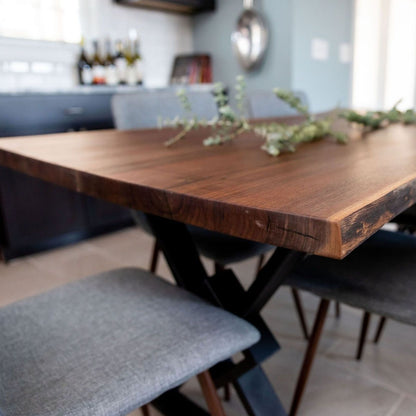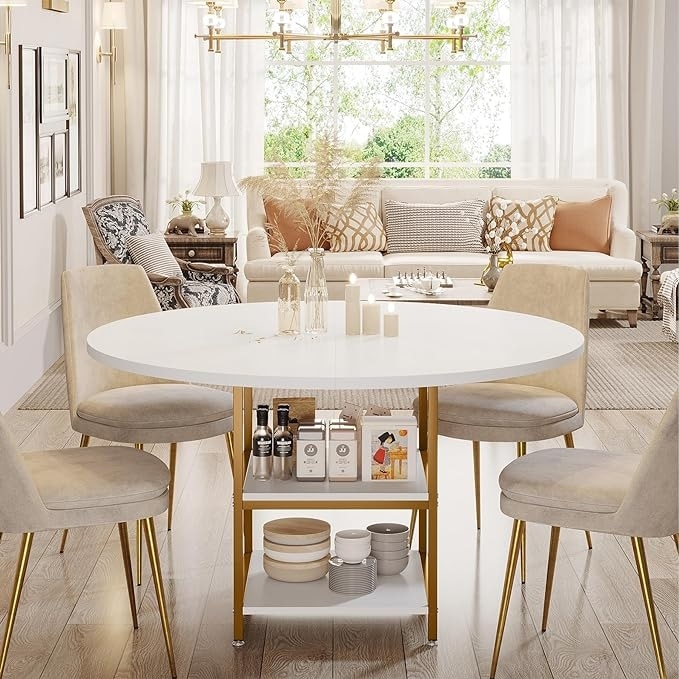From Traditional to Modern: Discover the Suitable Dining-room Table Legs for Your Design
While timeless designs such as cabriole and transformed legs stimulate a sense of timeless refinement, contemporary styles like barrette and geometric choices offer a possibility for striking aesthetic passion. As you consider these aspects, the question stays: exactly how can you seamlessly incorporate these varied leg styles to create a harmonious eating experience?
Comprehending Table Leg Styles
The range of dining-room table leg styles can considerably influence both the looks and capability of the space. Each leg design adds special aesthetic aspects and practical functions, satisfying varied design choices and usage needs. Understanding these designs is important for picking the appropriate eating table that aligns with your total indoor style vision.
As an example, conical legs use a clean, classic look that can enhance a room's style, while stand bases offer stability and make the most of legroom, making them perfect for smaller rooms. Hairpin legs, a hallmark of mid-century modern layout, present an industrial flair, permitting a ventilated, open feeling. Likewise, trestle legs stimulate rustic charm, giving durable assistance and a sense of eternity.
Wooden legs can bring heat and appearance, whereas metal alternatives usually communicate a streamlined, contemporary vibe. Inevitably, comprehending table leg designs is important for developing a cohesive eating location that reflects personal style while ensuring functionality and convenience.
Traditional Table Leg Options
When choosing dining area table legs, traditional choices usually embody timeless style and workmanship. These designs reflect a rich heritage and a dedication to quality, making them optimal for those that value traditional appearances.
One of the most famous typical leg designs is the cabriole leg, defined by its graceful rounded form. This layout often features decorative makings and is most commonly discovered in Queen Anne and Chippendale furniture. Another popular alternative is the transformed leg, which flaunts a collection of smooth, rounded forms that supply a timeless appearance while keeping security.
Furthermore, the straight leg, while simple, uses a sturdy and unadorned framework that can blend perfectly with a variety of tabletop styles. For those drawn to ornate detailing, claw-and-ball feet legs stimulate a feeling of majesty and can function as a stunning prime focus in any kind of eating area.
Finally, pedestal bases, although not purely legs, offer an alternate standard choice that enables enough legroom and can be perfectly carved. Each of these conventional leg styles adds to the general ambiance of a dining room, weding feature with aesthetic allure.

Modern Table Leg Styles
Modern table leg layouts use a varied variety of designs that emphasize ingenious products and tidy lines. These styles commonly prioritize performance while working as striking prime focus within a dining room. Minimalist aesthetics prevail, with legs crafted from materials such as steel, glass, and crafted wood, which add to a airy and contemporary feel.
One preferred design is the barrette leg, identified by its slim, tapered structure that gives read this post here security without overwhelming the tabletop (dining room table legs). This design is commonly found in mid-century contemporary furnishings and can effortlessly complement various dining table forms. One more fad is using geometric shapes, where legs may tackle asymmetrical or angular kinds, adding aesthetic passion and a touch of virtuosity

Blending Styles for Unique Areas
Often, home owners seek to create distinct dining rooms that reflect their individual design by mixing various design elements. This strategy enables the consolidation of varied visual appeals, resulting in an unified yet unique environment. Combining a rustic wooden table with smooth, contemporary metal legs can develop a captivating contrast that boosts the area's overall allure.
Furthermore, integrating vintage table legs with modern tabletops can evoke a sense of background while preserving a modern perceptiveness. Such mixes not only showcase private taste however also motivate creativity, allowing homeowners to curate an area that really feels both personal and welcoming.
Color plays a crucial duty in this blending process; picking table legs that match or comparison with the existing shade scheme can enhance visual passion. Whitewashed legs can soften the daring of a dark table surface, creating a well balanced visual.
Tips for Choosing the Right Legs
Choosing the right table legs is essential for accomplishing both performance and visual appeal in your eating space. Begin by taking into consideration the overall design of your area. Typical setups benefit from legs that feature intricate carvings or turned layouts, while contemporary rooms may call for streamlined, minimalist styles.
Next, evaluate the elevation and stability of the legs. dining room table legs. Standard eating tables range in between 28 to 30 inches in height, so ensure the legs enhance this measurement for convenience. Additionally, robust products, such as hardwood or steel, can boost stability and durability
Evaluate the leg form as well-- choices consist of straight, tapered, or pedestal layouts. Straight legs provide a traditional look, while conical legs can include a touch of sophistication. Pedestal bases provide enough legroom and are Continue optimal for smaller rooms.
Final Thought
In recap, choosing the perfect eating area table legs calls for mindful consideration of both contemporary and typical styles. Traditional options such as cabriole and turned legs use timeless sophistication, while modern layouts like hairpin and geometric forms supply a modern touch. By harmonizing leg design, height, and product linked here with the overall décor, a natural and welcoming environment can be accomplished. Inevitably, the selected table legs should show the wanted visual, boosting the eating experience within the space.
The selection of dining room table leg designs can considerably influence both the looks and performance of the space. Inevitably, recognizing table leg styles is essential for creating a natural dining location that reflects personal style while making certain usefulness and comfort.One of the most legendary typical leg styles is the cabriole leg, defined by its elegant bent shape. Straight legs supply a classic appearance, while conical legs can include a touch of beauty.In recap, choosing the suitable dining area table legs calls for careful factor to consider of both modern and standard styles.